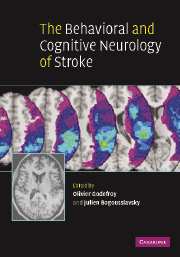Book contents
- Frontmatter
- Contents
- Contributors
- Preface
- 1 Evaluation of cognitive and behavioral disorders in the stroke unit
- Motor and gestural disorders
- Aphasia and arthric disorders
- Hemineglect, Anton–Babinski and right hemisphere syndromes
- Agnosia and Bálint's syndrome
- 14 Cortical blindness
- 15 Bálint's syndrome
- 16 Prosopagnosia
- 17 Object and color agnosia
- 18 Auditory disorders related to strokes
- Executive and memory disorders
- Behavioral and mood disorders
- Dementia and anatomical left/right syndromes
- Index
- References
15 - Bálint's syndrome
Published online by Cambridge University Press: 10 October 2009
- Frontmatter
- Contents
- Contributors
- Preface
- 1 Evaluation of cognitive and behavioral disorders in the stroke unit
- Motor and gestural disorders
- Aphasia and arthric disorders
- Hemineglect, Anton–Babinski and right hemisphere syndromes
- Agnosia and Bálint's syndrome
- 14 Cortical blindness
- 15 Bálint's syndrome
- 16 Prosopagnosia
- 17 Object and color agnosia
- 18 Auditory disorders related to strokes
- Executive and memory disorders
- Behavioral and mood disorders
- Dementia and anatomical left/right syndromes
- Index
- References
Summary
Introduction
Bálint's syndrome is a clinical entity which combines variously a set of complex spatial behavior disorders following bilateral damage to the occipital–parietal junction. The core syndrome is a triad, namely optic ataxia, gaze apraxia, and simultanagosia, to which visual–spatial perception deficits can be associated. Both diversity of terminology used in literature and bias in clinical descriptions, which often reflect a particular opinion of the authors on underlying mechanisms, add to the difficulty in describing and comprehending this rare and devastating syndrome. As the components are not elementary symptoms, and as they are not necessarily present in each case, indicating they do not rely upon a single brain mechanism, validity of the complex as a syndrome has been questioned (Rizzo and Vecera, 2002). Despite these flaws, Bálint's syndrome can be identified at the bedside examination and it allows robust anticipation of lesion localization.
Historically, Bálint provided in 1909 a thorough clinical and postmortem description of a patient who exhibited hitherto undescribed symptoms, he named Seelenlähmung des “Schauens,” optische Ataxie, raümliche Störung der Aufmerksamkeit, usually translated as psychic paralysis of gaze, optic ataxia, and spatial disorder of attention. He related these symptoms to a bilateral area of ischemic suffering in the posterior parietal and anterior occipital regions, including the angular gyrus and underlying white matter on both sides. In Bálint's view, psychic paralysis of gaze was a consequence of attention impairment and not of eye movement disorder per se; meanwhile optic ataxia was explained in terms of disconnection between visual and motor centers.
- Type
- Chapter
- Information
- The Behavioral and Cognitive Neurology of Stroke , pp. 294 - 314Publisher: Cambridge University PressPrint publication year: 2007



